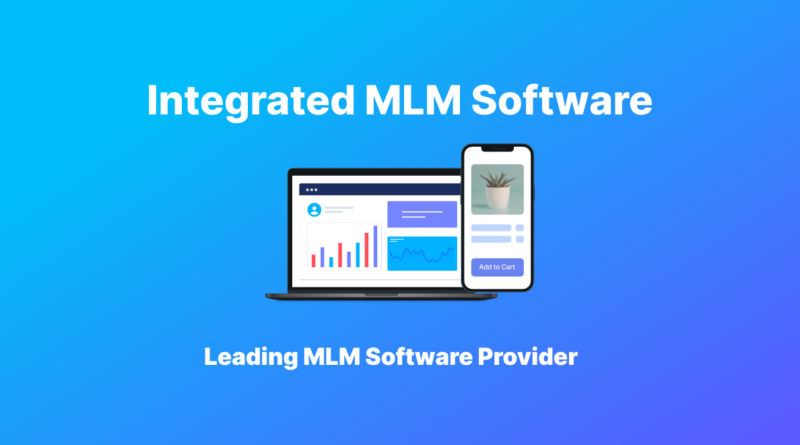How to Build the Best MLM Software for Your Business
Multi-Level Marketing (MLM) businesses thrive when supported by powerful and efficient tools. Building the best MLM software involves creating a solution that not only streamlines operations but also aligns with the unique requirements of your network. This guide walks you through the steps to develop software that empowers your MLM business, ensuring both functionality and scalability.
Assessing Your Business Needs
A comprehensive understanding of your MLM business is the foundation for creating effective software. Consider these key areas:
1. Business Objectives
A clear understanding of your business objectives is the first step in determining the scope of the software you’ll need. Identifying your primary goals will help prioritize features and ensure that the software you develop or implement aligns with your business vision. Consider these aspects when defining your business objectives:
- Improving Operational Efficiency: If your goal is to automate time-consuming processes like member registration, order management, or commission calculation, the software should be designed to reduce manual interventions. This can include automating payment distributions, tracking inventory, managing product orders, and providing real-time updates. Operational efficiency can also be enhanced through an intuitive dashboard that consolidates all critical metrics and makes data easily accessible for both distributors and administrators.
- Tracking Distributor Performance: MLM businesses rely heavily on performance metrics to track the success of their distributors. Key features, such as detailed performance dashboards, tracking of sales, recruitment, and downline performance, are essential. The software should allow managers and distributors to monitor sales targets, personal and team achievements, and commissions earned. It’s vital that the software enables distributors to track their own progress and performance easily, motivating them to achieve better results.
- Enhancing User Engagement: Engagement is crucial for long-term success in MLM. Distributors must feel supported and motivated to continue their efforts, and customers need a seamless, rewarding experience. Features such as leaderboards, incentive programs, achievement badges, and notifications about new promotions can help increase distributor motivation. Additionally, customer-centric features, such as personalized recommendations, loyalty programs, and a smooth user experience, can keep them engaged in making purchases and interacting with the brand.
Clearly defining your business objectives ensures that the software serves both short-term operational needs and long-term business growth strategies.
2. Target Users
Understanding who will use the software and tailoring the features to each user’s needs is essential to its success. The software should be designed with the user experience of each group in mind, ensuring that the tools and functionality align with their specific requirements.
- Distributors: These are the primary users of MLM software. They need tools that help them manage their sales, commissions, and downlines efficiently. Key features for distributors include tracking earnings, monitoring the progress of their network, accessing promotional materials, and communicating with their upline or downline members. A mobile-optimized platform is crucial to allow distributors to manage their business from anywhere.
- Customers: While distributors play a pivotal role in your business, customers are the backbone of any sales-driven MLM model. Customers need to have a seamless shopping experience, with easy access to products, order placement, and payment processing. Features such as product search, easy checkout, and the ability to sign up for membership or subscription plans should be intuitive and streamlined. Additionally, customer feedback and review systems can enhance the product experience.
- Administrators/Managers: Admin users are responsible for the day-to-day management of the business and ensuring everything operates smoothly. The software should provide administrators with comprehensive control over all aspects of the business, including member registration, product catalog management, commission structures, and financial transactions. Admins also require in-depth analytics and reporting tools to track overall business performance, monitor distributor activity, and ensure compliance with business policies.
Understanding the unique needs of each user group will help in designing the software to maximize productivity, ease of use, and user satisfaction.
3. Essential Features
Once your objectives and user needs are clear, it’s time to outline the essential features that will make your MLM software effective. These features should be chosen to support the overall business goals and enhance the experience for each user group.
- E-Wallet Systems: An integrated e-wallet system is crucial for managing and tracking commissions, bonuses, and transactions. Distributors need a secure way to manage their earnings and withdraw funds, while customers may require the ability to earn loyalty points or rewards. A flexible e-wallet system can support various payment methods, including digital wallets, bank transfers, and cryptocurrency options.
- Genealogy Trees: MLM businesses rely on a tiered, hierarchical structure. A genealogy tree feature visually represents this structure, showing the relationships between distributors, their downlines, and their positions within the company. This feature is vital for both distributors and admins to track growth, monitor team activity, and identify high-performing teams. Distributors can easily see their rank, the growth of their network, and the success of their downline, helping them plan their strategies.
- Commission Calculations: Accurate and timely commission calculations are the cornerstone of MLM operations. The software should be capable of calculating commissions based on various compensation plans, including binary, unilevel, matrix, or hybrid models. Additionally, the software should provide real-time updates on earnings, show how commissions are broken down, and give distributors transparency into how their income is calculated. The more automated and transparent these calculations are, the more trust distributors will have in the system.
- Robust Reporting Tools: Data-driven decisions are essential for the growth and success of an MLM business. The software should include powerful reporting tools that allow both distributors and admins to track key performance metrics. This could include sales reports, commission reports, downline performance, customer acquisition, and retention statistics. These reports should be customizable, real-time, and easy to interpret, helping users make informed decisions about their business activities and growth strategies.
By ensuring these essential features are in place, your MLM software will be equipped to handle the complexities of your business while enhancing the user experience for distributors, customers, and administrators.
Must-Have Features of the Best MLM Software
Developing software that stands out requires attention to features that enhance usability and functionality:
- User-Friendly Interface
A seamless and intuitive user interface is crucial for ensuring that distributors, customers, and administrators can easily navigate the platform without encountering confusion. The design should be clean, visually appealing, and organized, allowing users to find and access important features quickly. The interface should be responsive and adaptable across different devices and screen sizes, so that users have a consistent experience whether they are on a desktop, tablet, or smartphone. A user-friendly interface improves overall satisfaction, reduces onboarding time for new users, and boosts productivity as users spend less time figuring out how to use the platform.
- Flexible Compensation Plans
One of the defining aspects of MLM businesses is their compensation model. MLM software must be able to accommodate various compensation structures, such as Binary, Matrix, and Unilevel plans, and provide the flexibility to customize them as needed. With a flexible compensation system, your business can easily adapt to changing marketing strategies or adjust to new commission structures. The software should also support multi-level commissions, bonuses, and overrides to ensure that all levels of distributors are rewarded fairly. Additionally, the system should allow for easy modifications to compensation plans to accommodate growth or changes in the business model, keeping your MLM operation dynamic and scalable.
- Advanced Reporting Tools
Real-time data analysis is vital for making informed decisions in any business, and MLM is no exception. Advanced reporting tools are essential for both distributors and administrators to track performance, sales, commissions, and team progress. Customizable reports enable users to generate specific data tailored to their needs, whether it’s for sales performance, commission tracking, downline growth, or other key metrics. The ability to analyze trends, monitor business health, and pinpoint areas for improvement helps businesses stay agile and optimize their operations. Visualizations like graphs, charts, and tables make it easier to interpret the data and derive actionable insights that drive better decision-making.
- Secure Transactions
Security is a top priority when handling financial transactions, as MLM businesses involve frequent payments, commissions, and withdrawals. Integrating reliable and secure payment gateways is crucial for ensuring that users can make deposits, withdraw earnings, and process payments with confidence. The software should comply with industry-standard security protocols, such as SSL encryption, to protect user data and financial information from cyber threats. Additionally, multi-factor authentication (MFA) and other security measures can be implemented to further enhance account security. A secure transaction environment not only helps build trust with distributors and customers but also ensures compliance with legal and financial regulations.
- 5. Mobile Accessibility
With the increasing reliance on mobile devices for business management, MLM software must be optimized for mobile access. This includes responsive mobile-friendly web designs or dedicated mobile apps that allow users to manage their business operations on the go. Distributors can monitor sales, track commissions, communicate with their downline, and access promotional materials at any time, whether they’re at home, on the road, or in a meeting. Mobile accessibility empowers distributors to stay connected and productive, which is essential for an MLM business where success depends on active engagement and prompt decision-making. A mobile-optimized platform ensures that your MLM business can reach users wherever they are and provides a seamless experience across all devices.
Steps to Develop Your MLM Software
- Partner with Industry Experts
Collaborating with experienced developers ensures the inclusion of essential features while maintaining high-quality standards. Companies offering best MLM software often provide solutions tailored to the diverse needs of network marketing businesses.
- Select the Right Technology
Choose a scalable and secure tech stack that supports the software’s long-term functionality and growth.
- Design with Precision
Work closely with developers to create user-centric interfaces and workflows. Well-thought-out designs improve adoption and efficiency.
- Conduct Rigorous Testing
Test extensively for performance, security, and compatibility across devices to ensure a flawless user experience.
- Optimize Post-Launch
Gather user feedback to refine features and address any issues promptly, ensuring continuous improvement.
Understanding MLM Plans
The success of MLM software depends largely on how well it supports various compensation structures. When considering best MLM plans, ensure that the software accommodates different strategies like Binary, Matrix, and Unilevel models. Flexibility in plan configuration enables businesses to cater to unique distributor preferences and market demands.
Advantages of Custom MLM Software
Tailored software offers a range of benefits, including:
- Streamlined Operations: Automates processes like commission calculations and performance tracking.
- Improved Decision-Making: Access actionable insights through advanced reporting features.
- Scalability: Adapts effortlessly to your growing network’s needs.
By leveraging custom solutions, businesses can enhance operational efficiency and remain competitive in the ever-evolving MLM industry.
Final Insights
Creating the best MLM software requires a strategic approach that considers both present demands and future growth. By focusing on key features, partnering with professionals, and maintaining a user-first perspective, you can develop a solution that strengthens your MLM business.




